PUBLISHER: Global Market Insights Inc. | PRODUCT CODE: 1699412

PUBLISHER: Global Market Insights Inc. | PRODUCT CODE: 1699412
Household Vacuum Cleaner Market Opportunity, Growth Drivers, Industry Trend Analysis, and Forecast 2025-2034
The Global Household Vacuum Cleaner Market was valued at USD 25.9 billion in 2024 and is set to expand at a CAGR of 5% from 2025 to 2034. Increasing hygiene awareness and rising concerns over indoor air quality are key factors driving this demand. Many households are adopting vacuum cleaners as essential cleaning appliances, particularly with the growing incidence of allergies, respiratory issues, and other health concerns linked to poor indoor air conditions. Consumers are actively seeking models with advanced filtration systems that can trap dust, mites, and airborne particles, contributing to cleaner living environments. Manufacturers are responding by introducing energy-efficient, health-conscious designs that cater to modern user expectations.

Innovation in vacuum cleaner technology has led to the development of models with enhanced features, including antimicrobial coatings and tools designed for efficient pet hair removal. Smart technology is also becoming a defining aspect of modern vacuum cleaners, influencing manufacturers to integrate intelligent systems that optimize cleaning performance while conserving energy. These advancements are shaping purchasing decisions, with brands increasingly highlighting health benefits and efficiency in their marketing strategies.
| Market Scope | |
|---|---|
| Start Year | 2024 |
| Forecast Year | 2025-2034 |
| Start Value | $25.9 Billion |
| Forecast Value | $42.5 Billion |
| CAGR | 5% |
The market is segmented into various product types, including cordless, upright, canister, central, drum, wet/dry, robotic, and other models. Cordless vacuum cleaners, leading the segment, generated USD 7.9 billion in 2024 and are on track to reach USD 14.2 billion by 2034. This category remains popular due to its ease of use, lightweight design, and strong performance in different cleaning scenarios. Various vacuum types cater to specific cleaning needs-some offer powerful suction for larger carpeted areas, while others provide maneuverability for hard floors and compact spaces. The robotic segment continues to gain traction, driven by demand for low-maintenance, automated cleaning solutions.
The offline distribution channel accounted for approximately 57.8% of total sales in 2024, with steady growth projected over the next decade. Traditional retail outlets, including department stores and specialized appliance shops, remain significant due to their ability to offer hands-on product demonstrations. Customers prefer examining vacuum cleaners in person to assess design, functionality, and ease of operation before making a purchase. Trained sales professionals also play a role in guiding buyers toward models that align with their needs and preferences.
In the United States, the household vacuum cleaner market is growing at an annual rate of 5%, with demand focused on models equipped with smart features, cordless operation, and powerful suction capabilities. Consumers are increasingly interested in vacuums that integrate app connectivity, voice control, and multifunctional performance. As health consciousness rises, vacuum cleaners featuring advanced filtration systems designed to reduce allergens and airborne pollutants are seeing heightened adoption, reinforcing their importance in maintaining better indoor air quality.
Table of Contents
Chapter 1 Methodology & Scope
- 1.1 Market scope & definition
- 1.2 Base estimates & calculations
- 1.3 Forecast parameters
- 1.4 Data sources
- 1.4.1 Primary
- 1.5 Secondary
- 1.5.1.1 Paid sources
- 1.5.1.2 Public sources
Chapter 2 Executive Summary
- 2.1 Industry synopsis, 2021 - 2034
Chapter 3 Industry Insights
- 3.1 Industry ecosystem analysis
- 3.1.1 Factor affecting the value chain
- 3.1.2 Profit margin analysis
- 3.1.3 Disruptions
- 3.1.4 Future outlook
- 3.1.5 Manufacturers
- 3.1.6 Distributors
- 3.1.7 Retailers
- 3.2 Impact forces
- 3.2.1 Growth drivers
- 3.2.1.1 Urbanization and rising disposable incomes
- 3.2.1.2 Technological innovations
- 3.2.1.3 Increased focus on health and hygiene
- 3.2.2 Industry pitfalls & challenges
- 3.2.2.1 Environmental concerns and e-waste
- 3.2.2.2 Intense competition and price sensitivity
- 3.2.1 Growth drivers
- 3.3 Consumer buying behavior analysis
- 3.3.1 Demographic trends
- 3.3.2 Factors affecting buying decision
- 3.3.3 Consumer product adoption
- 3.3.4 Preferred distribution channel
- 3.3.5 Preferred price range
- 3.4 Growth potential analysis
- 3.5 Regulatory landscape
- 3.6 Pricing analysis
- 3.7 Porter's analysis
- 3.8 PESTEL analysis
Chapter 4 Competitive Landscape, 2024
- 4.1 Introduction
- 4.2 Company market share analysis
- 4.3 Competitive positioning matrix
- 4.4 Strategic outlook matrix
Chapter 5 Market Estimates and Forecast, By Type, 2021 – 2034 (USD Billion) (Thousand Units)
- 5.1 Key trends
- 5.2 Cordless
- 5.3 Upright
- 5.4 Canister
- 5.5 Central
- 5.6 Drum
- 5.7 Wet/Dry
- 5.8 Robotic
- 5.9 Others
Chapter 6 Market Estimates & Forecast, By Distribution Channel, 2021 – 2034, (USD Billion) (Thousand Units)
- 6.1 Key trends
- 6.2 Online
- 6.3 Offline
Chapter 7 Market Estimates & Forecast, By Region, 2021 – 2034, (USD Billion) (Thousand Units)
- 7.1 Key trends
- 7.2 North America
- 7.2.1 U.S.
- 7.2.2 Canada
- 7.3 Europe
- 7.3.1 UK
- 7.3.2 Germany
- 7.3.3 France
- 7.3.4 Italy
- 7.3.5 Spain
- 7.4 Asia Pacific
- 7.4.1 China
- 7.4.2 Japan
- 7.4.3 India
- 7.4.4 South Korea
- 7.4.5 Australia
- 7.5 Latin America
- 7.5.1 Brazil
- 7.5.2 Mexico
- 7.6 MEA
- 7.6.1 South Africa
- 7.6.2 Saudi Arabia
- 7.6.3 UAE
Chapter 8 Company Profiles (Business Overview, Financial Data, Product Landscape, Strategic Outlook, SWOT Analysis)
- 8.1 Bissell Inc.
- 8.2 De'Longhi Appliances S.r.l.
- 8.3 Dyson Ltd.
- 8.4 Electrolux AB
- 8.5 Eureka
- 8.6 Hoover
- 8.7 iRobot Corporation
- 8.8 LG Electronics Inc.
- 8.9 Miele & Cie. KG
- 8.10 Panasonic Corporation
- 8.11 Philips Electronics N.V.
- 8.12 Rowenta (SEB Group)
- 8.13 Samsung Electronics Co., Ltd.
- 8.14 SharkNinja Operating LLC
- 8.15 Vorwerk & Co. Interhold AG




